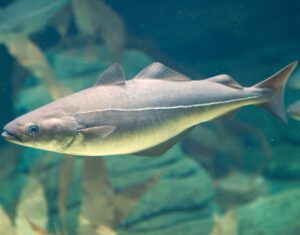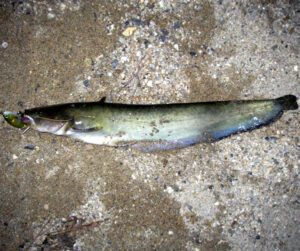A braided fishing line is a strong type of fishing line made by weaving together multiple strands of material like nylon or Dacron. It is known for its durability and thinness, which makes it less visible underwater and allows for longer casts.
Braided lines don’t stretch much, so they provide better sensitivity, helping anglers feel even the slightest nibbles from fish. Because of its strength, it’s commonly used for catching bigger fish or in situations where fishing conditions are tough, like around rocks or heavy vegetation.
Whatever, fishing is a hobby as old as time. Whether you are spending a quiet afternoon by a pond or battling with a trophy record marlin off the coast, every fisher knows how important reliable gear is.
At the heart of every fishing trip is fishing line, and there’s nothing simple about it. While monoline can get the job done, a braided fishing line is often the best choice.
Anglers love it for its strength and smaller environmental impact. Here’s a closer look at how both of those factors pair to make braided line a prime choice.
Understanding the Material of Braided Fishing Line
The appeal of braided fishing line is multifaceted. Their knitted or “braided” structure offers a slim diameter with significant strength. This means they can handle the energetic thrashing of a caught fish while maintaining low visibility underwater.
Without the need for frequent replacements due to breakage, these lines inadvertently foster a culture of sustainability. Anglers appreciate this durability since it means less disruption to the sport and less material waste over time.
Moreover, the tactile advantages of a braided line cannot be ignored in the angler’s experience. With virtually no stretch, braided lines transmit vibrations from lure to rod with greater efficiency, enabling anglers to feel even the slightest nibble from a tentative fish.
This heightened sensitivity means improved hook sets and more successful catches, aligning the angler’s skill with the effectiveness of the line.

Environmental Perspective
The production of braided lines may not seem like an environmental concern at first glance. However, the materials used, typically synthetics like nylon or Dacron, come from petrochemicals—resources we’re learning to use responsibly.
Some line manufacturers have responded by adopting recycled materials and reducing the ecological footprint of their manufacturing processes.
On a similar note, as people continue to grow more aware of their environmental impact, a promising trend is the commitment to green manufacturing processes when producing fishing gear, such as braided lines.
Manufacturers commonly do life-cycle assessments to minimize the impacts on ecosystems and seek out innovative ways to power their production lines with renewable energy, further aligning the industry with the ideals of environmental stewardship.
The Durability Factor
We’ve all been there: our lines get snagged, or a fish breaks it off. If you were using a plastic monofilament line, you’d be polluting your favorite fishing spot with a product that might take thousands of years to break down.
Braided fishing lines are often made from more environmentally sustainable materials that, while strong, will break down quicker and have less of an overall impact on our waters. When you select your fishing gear, you want it to be durable but sustainable simultaneously—braided line offers the best of both worlds.
Some braided fishing lines will take less than a decade to degrade in the wild, while others, like nylon, may take a long time. You must research your braided line ahead of time if sustainability is important to you.
Navigating Eco-Friendly Gear in Modern Angling
The days when society dumped its trash without care are long gone. Today’s modern consumer and modern tackle are more environmentally friendly and often specifically designed with sustainability in mind.
The biggest innovations have been using bio-based materials that won’t stick around in the water or shoreline for thousands of years like traditional plastic products do.
While not everything can be made of biodegradable materials, using materials that are more environmentally friendly to manufacture is certainly something that companies have been moving towards recently.
Wearing Your Environmental Commitment
It’s not just about the tackle. Clothing for anglers has also seen a surge of eco-consciousness. Across the board, apparel crafted from recycled plastics is becoming popular, making each item of clothing—be it a sun-protective hat or a waterproof jacket—an environmental statement.
Much like the sustainable fashion movements on land, aquatic apparel is catching up, providing choices that allow anglers to tread lightly on the marine environments they cherish.
Beyond recycled materials, there’s a growing trend for angling apparel to be treated with eco-friendly, non-toxic dyes and to employ ethical manufacturing processes.
Anglers can now choose gear that not only protects the environment but also supports fair labor practices, aligning with a broader conscientious consumer movement. Modern consumers appreciate both sustainability and social responsibility, giving a reason for manufacturers to change their methods of production.
The Interconnected World of Farming and Fishing
The connection between land and water has never been clearer. The health of our aquatic ecosystems is deeply intertwined with the practices of the agriculture industry. Farm runoff can enter rivers and lakes, affecting water quality and fish habitats.
Therefore, the move towards more sustainable gear in angling can also benefit the efforts of farmers striving to implement eco-friendly strategies on land. Such mutual goals forge a natural alliance between anglers and agriculturalists, each seeking to preserve the integrity of nature.
Education campaigns geared towards farmers and anglers alike prove instrumental in demonstrating how both practices can be harmful if not managed properly.
Organizations advocate for best practices tailored to preserve local ecosystems, encouraging collaborative efforts toward the shared objective of a healthier planet. These educational initiatives spotlight our collective responsibility to protect our waterways and land.
Investing in Community
There’s a unique charm in local tackle shops that their larger counterparts can’t replicate. These small businesses form the backbone of the fishing community and play a pivotal role in promoting the sport’s sustainable practices.
By engaging with these shops, communities invest in a localized economy and nurture the custodians of fishing tradition and environmental advocacy. These shops often collaborate with agricultural entities, reinforcing the bond between farmers and fishers—two groups reliant on Mother Nature’s benevolence.
These local hubs often function as informal educational centers, offering workshops and presentations on sustainable angling techniques and environmental preservation.
They promote catch-and-release fishing, selecting environmentally benign tackle, and introducing local conservation efforts, fostering a stronger, more informed community of Earth-conscious anglers.
Clean Waters, Better Fishing
The clarity of our waters is a barometer for the health of fishing recreation. Pollution, specifically from industrial and agricultural activities, threatens fish populations and the quality of the fishing experience.
Herein lies a shared responsibility; gear manufacturers, anglers, farmers, and the general public play a role in ensuring our waterways remain uncontaminated and full of life.
Political activism is a massively important factor in the fight for cleaner waters. Anglers can easily be powerful voices for better water quality by supporting legislation and voting for politicians who seek to protect our waterways from contaminants like microplastics, oil, and other pollutants.
Since fishers are often dealing with our waters on a frequent basis, their experiences are instrumental in highlighting the need for industrial and agricultural reforms. These reforms will bring about a better overall fishing experience and a brighter future for the planet on the whole.
How Recycled Gear is Making Waves with Anglers
The idea of recycling old equipment is becoming more prevalent these days as people become more and more conscious about their impact on the environment. Old fishing nets and discarded plastic lines are often turned into new lines, lures, and gear.
This reduces the need for new materials to be manufactured and minimizes waste. That said, manufacturing that kind of second-hand gear is challenging. It requires businesses to think of new and innovative ways to reuse old materials.
It can also be hard to effectively recycle materials and still be profitable enough to stay in business. These are challenges we must consider as consumers who are interested in purchasing such products.
Consumers, on the whole, are becoming more selective, seeking transparency in the sustainability claims of fishing gear brands. Companies are increasingly expected to disclose their supply chains and the environmental impact of their products.
This push for transparency can drive the entire industry toward a future where recycled and sustainable fishing gear is the norm, not the exception. The days when plastic monofilament lined the shoreline or could be found in the branches of every tree around a lake should soon become a thing of the past.
Casting a Line for the Future
The future of clean fishing depends on the education and engagement of the next generation. Many public initiatives are introducing sustainable practices to new anglers, ensuring they understand just what responsible fishing means.
Much like how the agricultural community invests in educating young farmers about sustainable practices, the fishing community must also build a sense of environmental responsibility in the next generation. From fishing clubs to school outreach programs, these formative experiences shape the conservation-minded anglers of tomorrow for the better.
Mentorship programs pairing seasoned anglers with novices are also becoming more and more popular, giving new fishers a hands-on approach to learning sustainable fishing practices. These programs often cover topics ranging from the ethical treatment of fish to how to respect local ecosystems and protect them.
The transmission of such knowledge is indispensable in creating a profound respect for the environment among new anglers and protecting our waters and aquatic life in the future.







I was searching for a good fishing line. This really answered my problem, thank you!